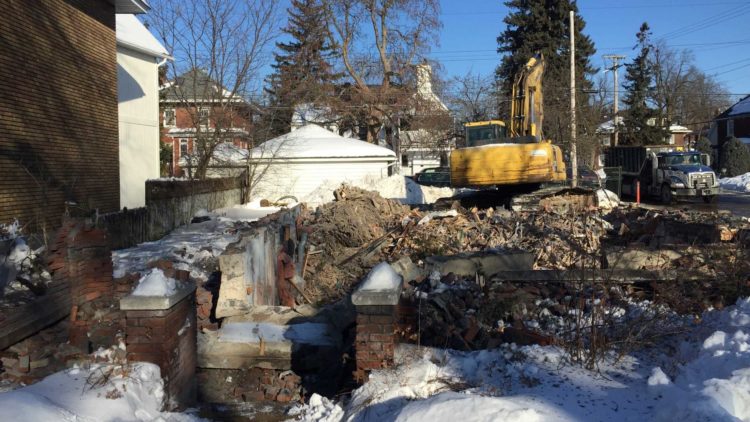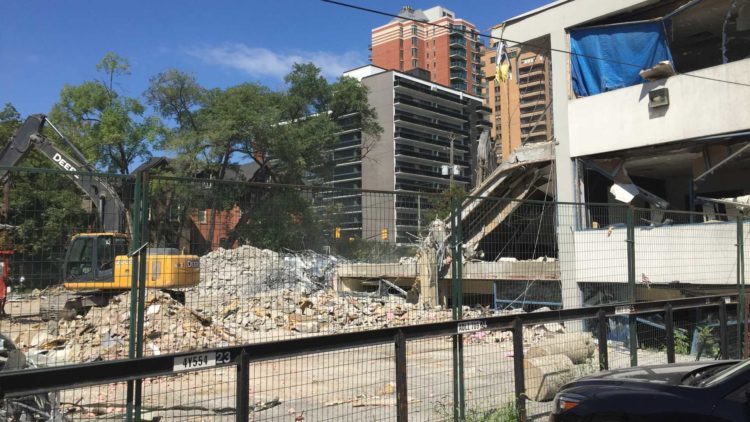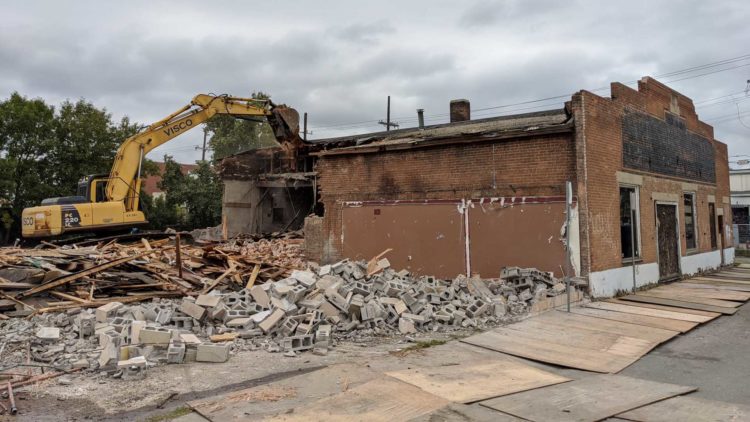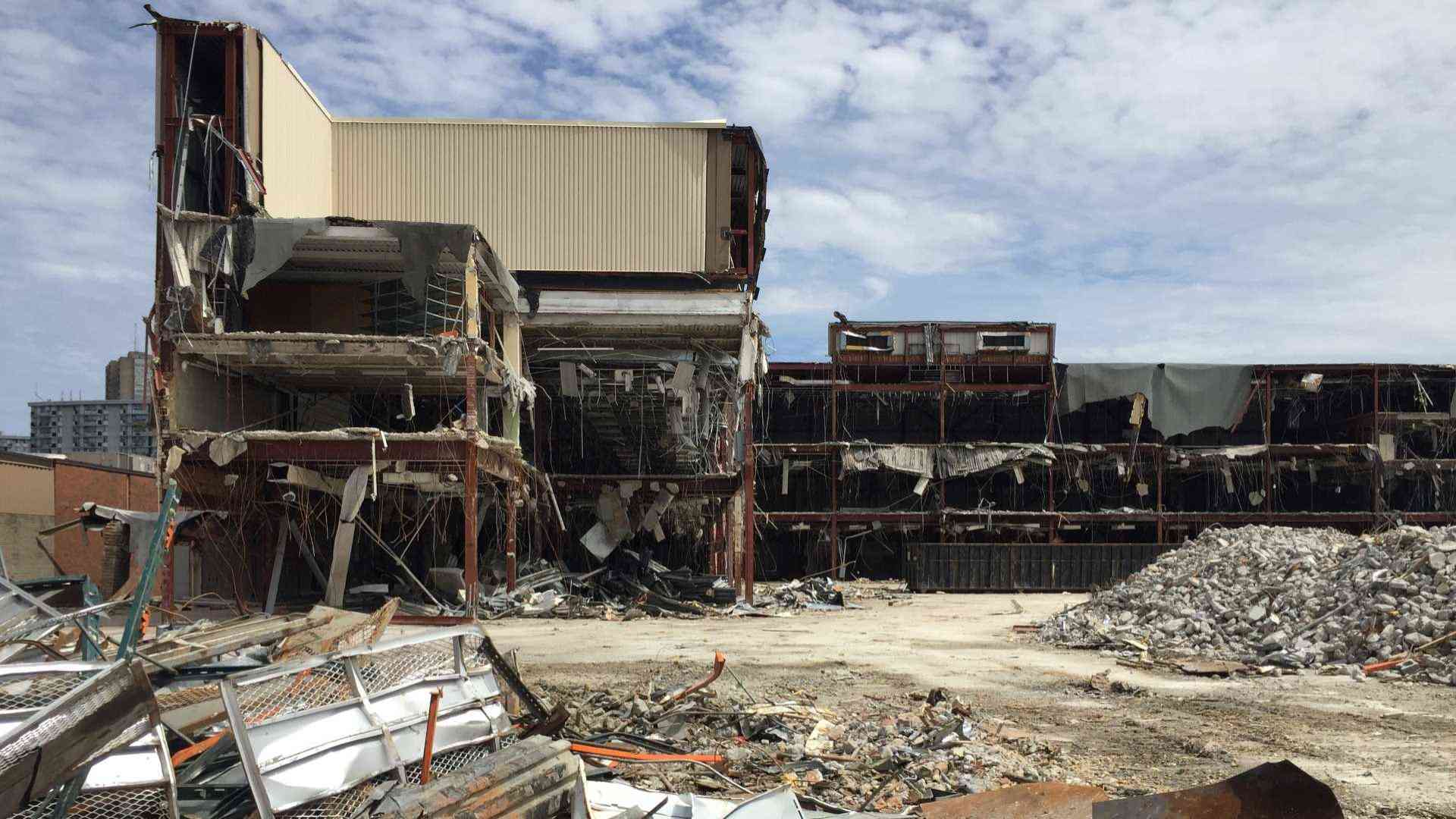
Demolition season in Canada is in full swing, and as you walk through downtowns or inner urban neighbourhoods you will likely pass large metal bins piled high with splintered materials, or backhoes carefully clawing buildings to pieces. Where does all this demolition come from, and is it an inevitable process? Why are some buildings reinvented and incorporated into new development, while others are discarded? There are systemic reasons driving this often needlessly destructive activity, and addressing them will help us meet our climate emergency goals.
In the U.S., the Federal Historic Preservation Tax Incentives Program has been tremendously successful over the past 40 years in encouraging private sector rehabilitation of historic buildings. Tax incentives have preserved more than 45,000 historic properties and enabled over 172,000 affordable housing units, leveraging US$102.64 billion in private investment (five times the value of the federal tax credits provided) and creating more than 130,000 skilled jobs each year.
The National Trust for Canada has pushed for similar federal tax incentives through its long-running Landmarks Not Landfill campaign, part of its effort to save and renew Canada’s heritage places since its creation in 1973 as a registered charity.

Systemic barriers holding back building reuse
In Canada, tax incentives like those in the U.S. were recommended in the 2017 House of Commons Environment Committee report Preserving Canada’s Heritage, and most recently in the 2021 Finance Committee report Investing in Tomorrow. But Canada’s Finance Department has long resisted this measure, and now the heritage sector realizes it needs to do a more robust job of identifying systemic barriers holding back building reuse in order to drive policy changes.
It is broadly recognized internationally that reusing and upgrading our existing buildings is one of the quickest ways to reach our climate action targets. The core idea of the well-known phrase “The greenest building is the one that already exists” is that existing buildings represent embodied carbon (GHG emissions already expended), and that they should be reused as long as possible. The 2018 report from the House of Commons Environment Committee Better Buildings for a Low-Carbon Future identified tracking embodied carbon as a key federal concern.
And it’s not just about carbon. The UN Environment Programme’s Global Resource Outlook 2019 warned that extractive industries (e.g., farming, fossil fuels, and metallic and nonmetallic mineral mining) are responsible for half the world’s carbon emissions and 90 per cent of biodiversity loss, with the greatest carbon-emissions increase in last 15 years coming from nonmetallic minerals extraction (e.g., sand, gravel and clay) largely associated with construction. Astonishingly, Canada sends 1.39 million tonnes of wood CRD (construction, renovation and demolition) waste to landfills each year, including precious old-growth lumber – and that’s an estimate, as Canada does an abysmal job of tracking its trash.

Addressing barriers to building reuse
In recent years the National Trust for Canada has been developing a body of insight and knowledge on barriers to the reuse of heritage and older buildings and the potential role of incentives, through research projects like the 2014 Financial Measures to Encourage Heritage Development. The 2020 National Trust report Making Reuse the New Normal: Accelerating the Reuse and Retrofit of Canada’s Built Environment leveraged interviews with key stakeholders and existing research to identify barriers to reuse in Canada’s real estate development industry and marketplace – municipal planning, the design and construction industries, and property buyers. The report then identified actions to address these barriers in four key areas: cultural, physical/technical, regulatory and economic/marketplace.
The cultural barriers are some of the most challenging to pin down, but they are possibly the most important. Obsolescence studies show that most buildings are bulldozed well before they become structurally unsound, because it is easy to do so (demolition permits are cheap and available “as a right”), and because consumers persist in viewing new buildings as a sign of progress. Designed as economic stimulus after the Second World War, the notion of premature obsolescence that is built into modern tax systems and accounting practices (depreciation) has helped drive a culture of environmentally destructive consumption and disposability.
When it comes to physical and technical barriers, limited professional and trades knowhow about older buildings increases the risk of unknowns with older buildings and drives away redevelopment. Knowledge about heritage buildings is unevenly distributed in Canada – it is concentrated in areas like Vancouver, Toronto, Ottawa and Montreal. This is a hidden barrier across the country, because building owners get advice and repair quotes from professionals and workers, who might have limited experience with older buildings and often push owners toward costly, inappropriate responses or outright demolition.
Another factor is that the rehab costs for older buildings are often inflated by years of deferred maintenance. The tax system tends to reward owners who do not maintain their properties, while owners who invest and improve get punished with higher taxes as their property value increases. Properties with heritage designation are sometimes allowed to degrade in the anticipation that their eventual demolition through neglect will open up the site’s maximum development potential.
Beyond physical constraints, the reuse of older buildings is further suppressed by the future development potential of a property, which is prescribed by municipal regulation. An older building on a site that is zoned for a considerably higher density or the possibility of density through upzoning will also inflate land values, encourage speculation and contribute to demolition by neglect. Upzoning on sites can have a ripple effect on nearby properties, creating precedents that drive copy-cat requests (difficult for municipal councils to refuse) and can suppress investment in existing buildings in the immediate area.

Complying with new building codes can be a hurdle
The need to comply with new codes – e.g., fire, safety, accessibility, energy and seismic codes – triggered by a building’s change of use is often one of the biggest hurdles to overcome in the revitalization of older buildings. Canada’s national codes do not have requirements for existing buildings, and the Environment Committee report Preserving Canada’s Heritage recommended that this be changed. While the codes allow “alternative compliance methods” or “equivalency” opportunities, many building inspectors are unwilling to step outside contemporary building techniques. The easiest path for the designers and building inspectors, then, is to stringently follow code, which creates a powerful disincentive for reusing older structures. California’s Historical Building Code and the New Jersey Rehabilitation Subcode blaze the trail on reform and are potential models for Canada.
There are also economic barriers: two property tax situations can push an existing building toward demolition ─ a tax assessment on “highest and best use” and the tax advantages of surface parking lots. Existing buildings – the social enterprise hub 401 Richmond Street in Toronto was a recent case – can be priced out of the land they sit on if property tax rates are grossly inflated by their development potential or land value. Conversely, the lower property tax rates for surface parking lots in parts of Canada can provide another push for owners to demolish their buildings and await future development.
On the economics side, it is more difficult to obtain financing from Canadian banks for older/heritage building rehabilitation projects. Lenders often gravitate toward developers who can use reliable formulas and precedence to determine project costs or an expected loan-to-value ratio. These formulas are a poor fit for many reuse projects, as each project is unique. Banks, however, need comparables to assess risk and need up to 10 other buildings to understand market value. Owing to this uncertainty in financing options and lack of support from banks and lenders, the majority of heritage projects must be either self-financed or privately financed (at high rates). Stakeholders in the Making Reuse the New Normal project suggested that the creation of alternate funding sources with older building reuse expertise would be hugely beneficial, as would the introduction of a federal rehabilitation tax credit for older building rehabilitation.
To meet our climate action targets, Canada needs to remove the barriers to building reuse and foster a stronger supply chain of ideas to help building owners and users reinvent, not demolish, existing structures. The greenest solution is to follow the 5 Rs – Refuse, Reduce, Reuse, Repair, Recycle – and only then to Replace, not to default to material-intensive new construction.
This article is part of the Reshaping Canada’s Cities After the Pandemic Shockwave special feature.










